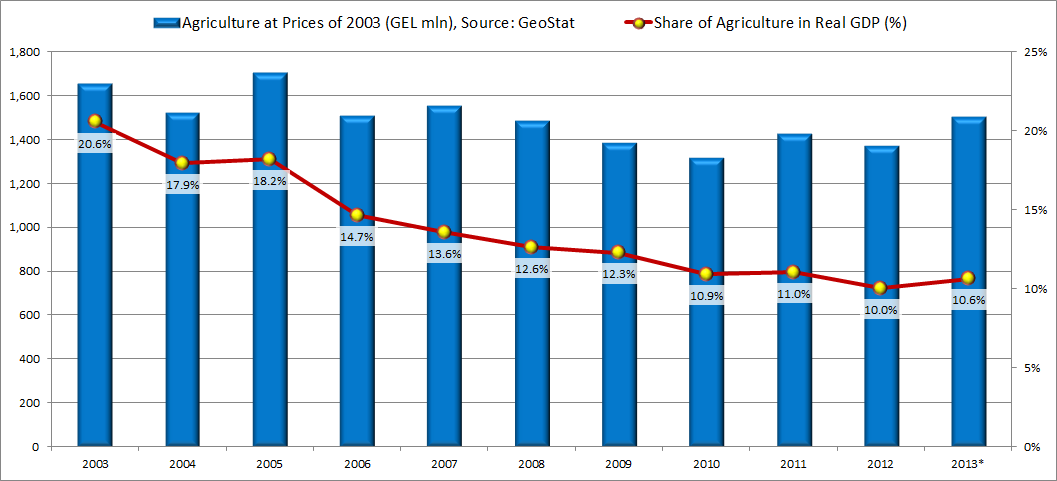On 10 April 2014 present Tbilisi mayoral candidate and Minister of Infrastructure at the time summarised the outcomes of the Preferential Agro-credits project and stated: “…These projects are of special importance in terms of regional development as well as considering that they create jobs, increase the income of Georgian families and, most importantly, encourage the national production of goods. We were not exactly indulged with domestically produced agricultural goods and so,consequently, the share of agriculture in the GDP amounted to solely 8%. In 2013, however, owing to state funded projects, the indicator rose to 12%. This is a tendency of increase which is maintained in 2014. More projects are expected to be funded this year which will have a greater impact upon the economic development of the country.”
FactChecktook interest in Davit Narmania’s statement and verified its accuracy.
Throughout the years 2003-2010 the share of agriculture in the nominal GDP of Georgia was characterised with a tendency of decrease. In 2011-2013, however, the indicators saw an upturn as compared to 2010. In line with the preliminary data of 2013, the share of agriculture reached 9.3% which equals GEL 2.17 billion in absolute numbers and which represents the highest indicator recorded over the last four years. The growth of the percentage share of agriculture in the GDP indicates that in 2013 agriculture grew in respect to certain other sectors. It follows, therefore, that if all the sectors of the economy had grown equally, all of them, including agriculture, would have retained the same share in the GDP as in the previous year.

As for the share of agriculture in the real GDP, over the span of the years 2003-2012 this indicator was characterised with a decreasing trend and took a slight upturn in 2013 reaching 10.6%.

It is also to be noted that the extent of any particular sector’s share in the GDP indicates what part of the country’s income is accumulated in the given sector. The higher the indicator the larger the share of revenues accumulated in this sector and the more important the role of this sector in the economy.
A large share of agriculture in the GDP is mainly characteristic for underdeveloped countries and for some developing countries. As for developed countries, the share of agriculture in their GDP is fairly low although the absolute indicator of the agricultural sector is quite large. The large share of the GDP in developed countries is occupied by capital intensive industries whereas agriculture belongs to labour intensive fields characterised with a diminishing return to scale.

As the subsidies and taxes are not divided according to the sectors of the economy, GeoStat calculates the ratio of the absolute indicator of agriculture and the GDP at basic prices. If we compare the indicators of the real GDP recorded in 2003 and 2012 (calculated at prices of 2003) we observe that in 2003 the real GDP totalled GEL 8.04 billion, agriculture – GEL 1.65 billion and its share in the real GDP – 20.6%. The real GDP of 2012 amounted to GEL 14.15 billion, agriculture – GEL 1.5 billion and its share in the real GDP – 10.6%. Even upon the basis of these indicators only it can be safely said that a large share of agriculture in the GDP may not be a favourable indicator for a country’s economy.
As Georgia advances economically the share of agriculture in the country’s GDP is expected to shrink. Obviously, this does not imply a decrease in the absolute indicator of agriculture. Georgia’s economic development will be accompanied by an increase in the absolute indicator of agriculture. After the economic expansion and the development of capital intensive fields persons employed in agriculture will move to other fieldsin pursuance of higher incomes. Consequently, the share of people employed in agriculture, which currently accounts for over half of the total employment in Georgia, will decline markedly.
Conclusion
The share of agriculture in the nominal GDP amounted to 9.3% in 2013 which undoubtedly is the highest indicator registered over the course of the last four years. In the case of the real GDP (expressed at prices of 2003), the share of agriculture equals 10.6%. Consequently, the number indicated by the former Minister – 12%, is not entirely accurate. Throughout the years 2010-2012 the share of agriculture in the GDP varied at around 8%; therefore, Davit Narmania is correct in this part of his statement.
FactCheckconsiders it necessary to point out that the increase of the share of agriculture in the GDP hardly qualifies as a favourable factor seeing that if all sectors of the economy developed at an equal pace their shares in the country’s GDP would remain unchanged. It is of greater importance to Georgia to develop capital intensive industries which are characterised with increasing returns and will significantly increase employment in the country.
Taking into consideration the circumstances elaborated above, we conclude that Davit Narmania’s statement, “…These projects are of special importance in terms of regional development as well as considering that they create jobs, increase the income of Georgian families and, most importantly, encourage the national production of goods. We were not exactly indulged with domestically produced agricultural goods and so, consequently, the share of agriculture in the GDP amounted to solely 8%. In 2013, however, owing to state funded projects, the indicator rose to 12%. This is a tendency of increase which is maintained in 2014. More projects are expected to be funded this year which will have a greater impact upon the economic development of the country,” is HALF TRUE.Originally published in The Financial, issue N. 20(400)
















